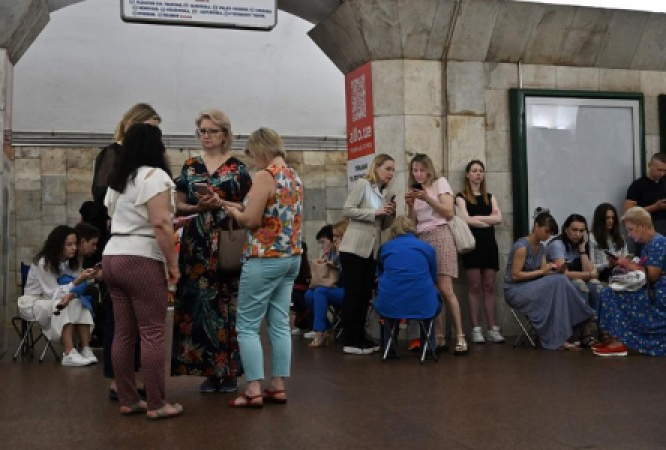
Kyiv: In order to create a precarious descent to a bomb shelter east of Kyiv, the capital of Ukraine, an old door has been placed over a set of broken steps.
Locals light torches inside to view the enormous room that was originally built decades ago and furnished with restrooms, water tanks, two distinct entrances, and a ventilation system.
However, given the ongoing conflict with Russia and Moscow's persistent attacks on Kyiv, this Cold War-era bomb shelter is no longer operational.
Also Read: Images of the attack in which Americans were pushed down a slope are sought by German police
The shelter, which is located beneath an abandoned structure, lacks lighting, and the ventilation shaft is clogged with garbage. Here, just a few homeless people slumber.
It has been in this condition for ten years, according to 43-year-old Oleksandr, a local.
This actually is a bomb shelter. 350 people could fit in this space if it were cleaned up, or almost two apartment buildings, according to Kateryna Shylo, a 42-year-old mother of three who lives close to the shelter on Suleiman Stalsky Street.
Despite a formal push to inspect and upgrade the facilities, residents are angry that the authorities have abandoned the bomb shelter that was built specifically for that purpose.
This followed a recent tragedy in which, on June 1, while attempting to enter a locked shelter in a Kyiv clinic during nighttime strikes, a mother, her 9-year-old daughter, and another woman were all killed by missile debris.
As a result, over 4,600 air-raid shelters in Kyiv were inspected this month by a commission that included the mayor of Kyiv, Vitali Klitschko.
It determined that 65% of the samples could be put to use, while another 21% required improvement and 14% were unfit for their intended use.
Nearly a third needed a phone call to a keyholder in order to gain entry.
Due to the possibility of nuclear war, bomb shelters were constructed all around the city during the Soviet era and maintained on a regular basis.
Since then, numerous have deteriorated.
The Suleiman Stalsky Street shelter was illegitimately privatised and passed through many hands. It is no longer even indicated on a directory of public shelters.
However, "people came here at the beginning of the war — there was no other option,"
Residents tried to make improvements in the early months following the Russian invasion in February 2022 by bringing beds, chairs, and benches, but they frequently had to clean up human waste in a space shared with drug addicts and the homeless, according to Shylo. It was also very cold sleeping there.
We simply grew weary of it.
Also Read: Serbian court mandates the detention and inquiry of three Kosovo police officers
According to Oleksandr, authorities could "influence the owner by legal means to bring the premises into proper condition."
The bomb shelter is classified as "class 2," which is the second-highest level of blast wave protection.
Compared to cellars, the most basic type of shelter, this is much safer.
It has a total area of 234 square metres and was constructed in 1982 to accommodate up to 350 people.
The place had everything, including bunk beds and gas masks, recalled 67-year-old Ganna Skirsko, who used to clean there.
However, in a letter to a resident this month that was made available to AFP, district official Pavlo Babiy claimed that restoration was "not economically feasible" because it would cost 1.8 million hryvnias ($51,000).
An official shelter on Beresteiskiy Avenue in western Kyiv appears to be much cleaner. However, there are also damaged toilets, rusty water tanks, and ventilation pipes. The paint is flaking off the mouldy walls.
At the beginning of the war, when many people used it, the shelter was being used for storage, but locals cleaned out trash and placed basic furniture inside.
Local resident Anna Boryshkevych descends there with just one other person as an air raid siren blares.
The 30-year-old claimed that most people avoid the shelter.
There are 300 to 400 square metres, I believe. All of the residents of this apartment block could stay here if it were properly constructed, but they don't really want to, according to the coordinator of the public health centre.
"It's not worthwhile for someone to stay here — you try to weigh your chances: maybe it's better to stay at home in comfort."
She pointed to the steep steps down and said that many of the residents of the 1960s-era building above are elderly.
"How can someone in a wheelchair get down here? That is a query that is never even raised.
Also Read: Malaysian Pilgrims Embrace Smooth Makkah Route and Bask in Warm Saudi Hospitality!"
The electric light in the shelter has at least been fixed, according to Boryshkevych, who links this to the government's response to recent fatalities.
She claims that there are calls for change after every new tragedy, but that "you somehow get used to not having a normal shelter."